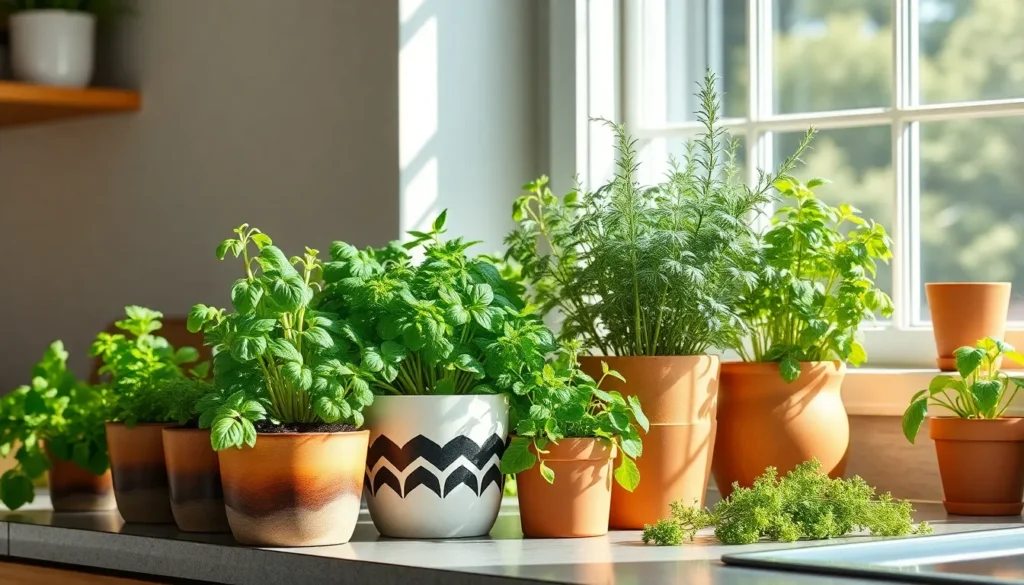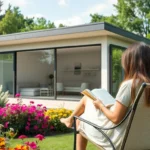Fresh herbs at your fingertips – imagine snipping basil for tonight’s pasta or grabbing mint for your morning tea without stepping outside. We’re about to transform your kitchen into a thriving herb paradise that’ll make your neighbors green with envy.
Growing an indoor herb garden isn’t just trendy – it’s practical magic. You’ll slash grocery bills while elevating every meal with flavors that put store-bought herbs to shame. Whether you’re working with a sunny windowsill or a dark corner that needs some creative lighting answers we’ve got ideas that’ll work for your space.
From space-saving vertical gardens to countertop setups that double as décor we’ll show you how to create an herb haven that fits your lifestyle. Ready to discover which herbs thrive indoors and learn the simple tricks that guarantee success? Your taste buds are about to thank you.
Choose the Perfect Location for Your Indoor Herb Garden
Selecting the right spot for your indoor herb garden directly impacts how well your plants will thrive and grow. We’ll walk you through the key factors that determine the success of your herb gardening venture.
Assess Natural Light Availability
South facing windows provide the most consistent light for herb growth throughout the day. Most culinary herbs like basil, oregano, and thyme need 4 to 6 hours of direct sunlight daily to produce their flavorful oils. We recommend measuring light intensity using a smartphone app or light meter to ensure your chosen spot receives adequate illumination.
East facing windows offer gentle morning sun that works well for delicate herbs. Herbs such as parsley, cilantro, and chives tolerate partial shade conditions and actually prefer protection from harsh afternoon rays. These locations typically receive 3 to 4 hours of direct morning light.
West facing windows can work but may require afternoon shade protection. The intense heat from western exposure often stresses Mediterranean herbs like rosemary and sage during summer months. We suggest using sheer curtains or moving plants back from the window during peak afternoon hours.
Supplement with grow lights when natural light falls short. LED grow lights positioned 6 to 12 inches above plants can extend growing seasons and support herb production in darker spaces. Full spectrum LED units consuming 24 to 40 watts work effectively for small herb gardens.
Consider Temperature and Humidity Levels
Indoor temperatures between 65°F and 75°F create optimal growing conditions for most herbs. Basil and other warm weather herbs prefer the higher end of this range while cool season herbs like mint thrive closer to 65°F. We avoid placing herb gardens near heating vents or air conditioning units that create temperature fluctuations.
Humidity levels around 40% to 50% support healthy herb growth without encouraging fungal issues. Kitchen locations naturally provide higher humidity from cooking activities but bathroom windows may create excessive moisture. We use humidity trays filled with pebbles and water to increase moisture around plants when needed.
Air circulation prevents stagnant conditions that lead to plant diseases. Gentle airflow from ceiling fans or open windows strengthens herb stems and reduces pest problems. We position plants where they receive indirect air movement without cold drafts.
Avoid temperature extremes that stress herb plants and reduce essential oil production. Locations near exterior doors, uninsulated windows, or heat sources create challenging growing environments. We monitor temperature variations using digital thermometers to identify stable microclimates.
Evaluate Available Space and Accessibility
Counter space near the kitchen sink provides convenient access for daily harvesting and watering. Windowsill herb gardens require 4 to 6 inches of depth to accommodate standard herb pots. We ensure surfaces can support 2 to 3 pounds per square foot when containers are fully watered.
Vertical wall space maximizes growing area in compact kitchens and apartments. Wall mounted planters or hanging systems can accommodate 8 to 12 herb varieties in a 3 by 4 foot area. We install proper wall anchors rated for the total weight of plants, soil, and water.
Floor space accommodates larger herb garden setups with multiple growing levels. Rolling plant carts or tiered stands allow us to move herb gardens for optimal light exposure throughout seasons. These systems typically measure 2 to 3 feet wide and can hold 15 to 20 herb plants.
Accessibility for maintenance determines long term success of indoor herb gardens. We position plants within easy reach for pruning, watering, and harvesting without requiring step stools or stretching. Regular care becomes simpler when herb gardens integrate naturally into daily kitchen routines.
Select the Right Containers for Your Herb Garden Setup
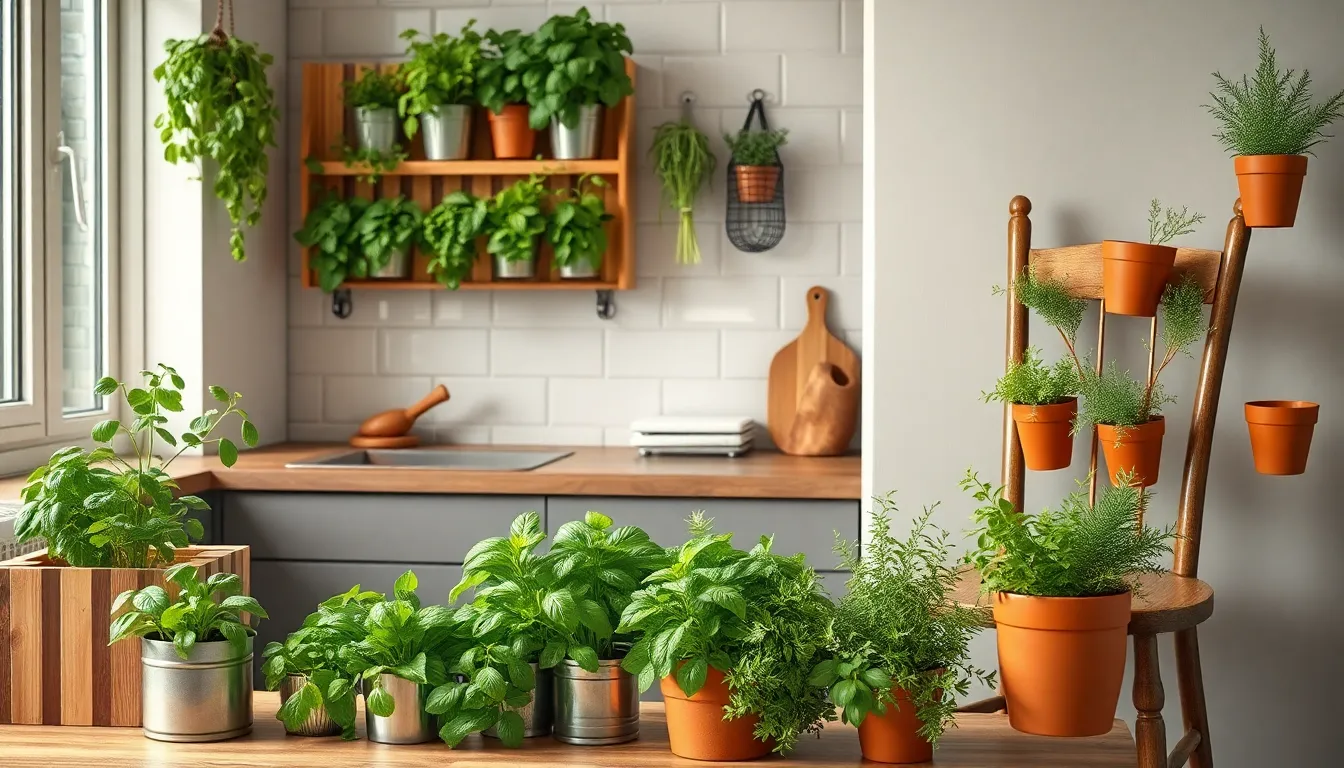
Choosing the appropriate containers for your herb garden directly impacts plant health and growth success. We’ll explore various container options that maximize space while ensuring optimal growing conditions.
Traditional Pots and Planters
Cedar containers offer natural moisture resistance and insect repelling properties for herb cultivation. We recommend these wooden planters for their durability and organic appeal in kitchen environments.
Steel planters provide excellent drainage and modern aesthetics while maintaining temperature stability. These containers work particularly well for herbs requiring consistent moisture levels like basil and cilantro.
Terra cotta clay pots create breathable environments that prevent root rot through natural porosity. We suggest these classic containers for Mediterranean herbs such as rosemary and thyme that prefer well-draining soil.
Drainage holes are essential features that prevent waterlogged roots and plant death. Ensure every container includes adequate drainage regardless of material choice.
Food-grade materials guarantee safe herb consumption without chemical contamination. We prioritize untreated, organic-certified containers for the healthiest herb growing experience.
Vertical Garden Systems
Wall-mounted systems maximize growing space in compact kitchens and apartments. These arrangements allow us to cultivate multiple herb varieties without sacrificing counter space.
Built-in irrigation features optimize water distribution across all plants simultaneously. We find these systems reduce maintenance time while ensuring consistent moisture levels.
Corner installations use often-overlooked spaces for productive herb growing. These vertical arrangements can accommodate 6-8 different herb varieties in a 2-foot square area.
Room divider applications serve dual purposes by separating spaces while providing fresh herbs. We recommend these systems for studio apartments and open-concept homes.
Repurposed Household Items
Old chair transformations create unique herb planters by attaching containers to chair frames. We suggest securing 3-4 small pots to create tiered growing levels.
Plastic bottle planters offer budget-friendly answers for herbs with shallow root systems. Cut bottles in half to create mini containers perfect for basil, mint, and oregano.
Wooden crate gardens provide rustic charm while accommodating multiple herb varieties. These repurposed containers work exceptionally well for creating tiered arrangements with varying heights.
Self-watering modifications can be added to any repurposed container using simple wick systems. We recommend this approach for busy gardeners who travel frequently.
Pick the Best Herbs for Indoor Growing Success
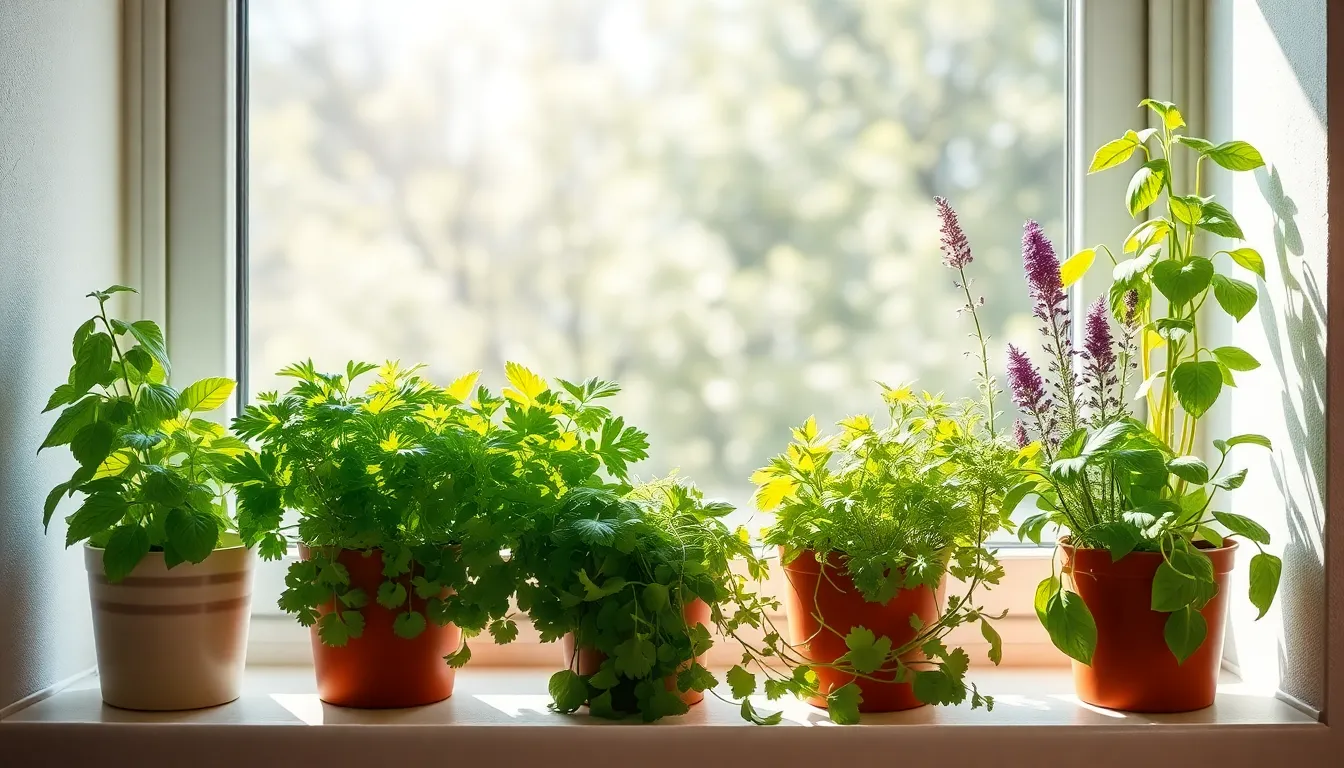
Selecting herbs that naturally thrive in indoor conditions sets the foundation for a successful garden. We’ve found that certain varieties adapt remarkably well to container growing and limited natural light conditions.
Easy-to-Grow Beginner Herbs
Basil tops our list for newcomers since it loves heat and bright light conditions that many homes provide naturally. This aromatic herb grows quickly and responds well to regular harvesting, making it perfect for first-time indoor gardeners.
Parsley offers excellent versatility as it grows well in cooler conditions than most herbs require. We recommend this hardy herb because it tolerates lower light levels and provides continuous harvests throughout the growing season.
Cilantro delivers fast results with minimal care requirements, sprouting within days of planting. Its quick growth cycle means you’ll enjoy fresh leaves within weeks, providing immediate satisfaction for beginning gardeners.
Dill prefers well-draining soil and moderate sunlight, making it ideal for east or west-facing windows. This delicate herb grows efficiently in containers and adds fresh flavor to countless dishes.
Culinary Herbs for Cooking Enthusiasts
Rosemary excels for roasted meats and Mediterranean dishes, thriving in sunny indoor locations with good air circulation. This woody herb develops robust flavors when grown indoors and tolerates occasional watering lapses.
Thyme proves essential for soups and sauces, growing compactly in small containers while producing abundant harvests. We’ve observed that this hardy herb adapts well to various indoor growing conditions.
Marjoram adds a sweet pine flavor to dishes and grows more readily indoors than its cousin oregano. This gentle herb prefers consistent moisture and moderate light conditions.
Tarragon brings authentic French cuisine flavors to your kitchen, particularly the French variety that doesn’t produce viable seeds. We recommend purchasing established plants for this sophisticated culinary herb.
Medicinal and Aromatic Herb Varieties
Lemon balm provides calming properties while growing vigorously in indoor containers with minimal maintenance. This mint family member spreads quickly, making regular harvesting beneficial for both plant health and herbal tea preparation.
Lemon verbena offers intense citrusy aroma and grows well in bright indoor locations with good drainage. We appreciate its concentrated lemon scent that surpasses even fresh lemon peel in intensity.
Lavender delivers calming effects through its essential oils and adapts to indoor growing with proper light exposure. This Mediterranean herb requires well-draining soil and benefits from occasional pruning to maintain compact growth.
Scented geraniums provide a variety of fragrances including rose, mint, and citrus depending on the cultivar chosen. These aromatic plants thrive indoors and offer both visual appeal and delightful scents when leaves are gently brushed.
Create a Windowsill Herb Garden Display
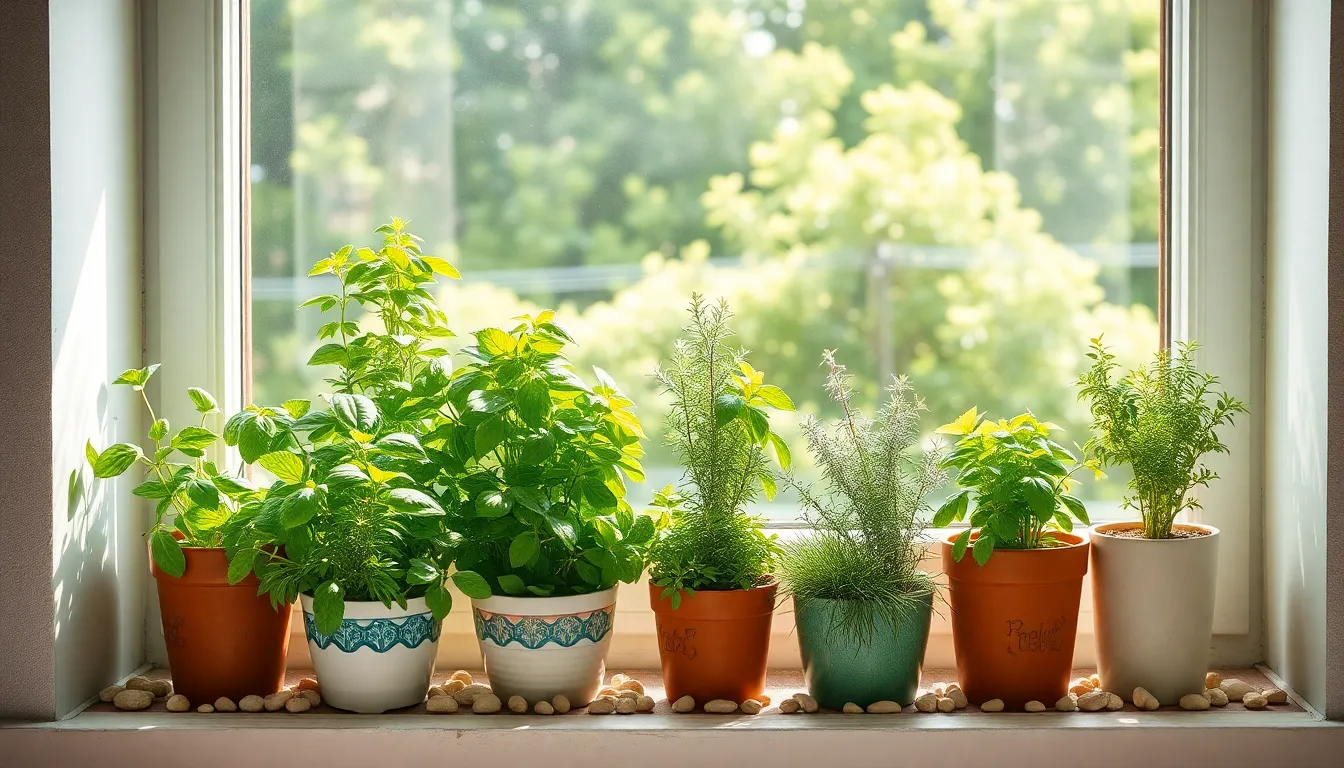
Windowsill herb gardens transform ordinary kitchen windows into productive growing spaces that provide fresh herbs within arm’s reach. We’ll show you how to create an attractive and functional display that maximizes your available space.
Maximize Small Window Spaces
Vertical gardening answers help us grow multiple herbs in compact windowsill areas. Stackable planters allow us to create tiered displays that house different herb varieties without overwhelming the space. Window box planters attached directly to the sill extend our growing area beyond the traditional pot arrangement.
Trellis systems mounted against the window frame support climbing herbs and create visual interest. Multi level plant stands positioned near windows accommodate various pot sizes while maintaining easy access for harvesting. Corner spaces beside windows become productive growing areas when we use triangular or curved planters designed for tight spaces.
Design Attractive Arrangements
Mixed herb combinations create visually appealing displays that serve both aesthetic and culinary purposes. We can pair tall herbs like rosemary with shorter varieties such as thyme to establish natural height variation. Color contrasts emerge when we combine purple basil with green sage or silver leafed herbs alongside bright green parsley.
Decorative elements enhance the overall appearance of our windowsill gardens. Small decorative stones placed around plant bases provide visual texture while helping retain soil moisture. Pebbles or moss scattered between pots create cohesive arrangements that look professionally designed. Matching or complementary pot styles unify the display while reflecting our personal taste preferences.
Manage Light Requirements
Natural light placement determines which herbs thrive in our windowsill gardens. South facing and west facing windows receive more than six hours of direct sunlight daily, making them perfect for sun loving herbs like basil and rosemary. Herbs requiring partial sun or shade, including mint, chives, and lemon balm, perform well in east facing windows or areas with filtered light.
Grow lights supplement natural illumination during winter months or in low light conditions. Full spectrum LED lights positioned 12 to 18 inches above plants provide adequate illumination for 12 to 14 hours daily. Timer controlled lighting systems ensure consistent light exposure without requiring daily attention, helping our herbs maintain steady growth throughout darker seasons.
Build a Vertical Indoor Herb Garden Wall
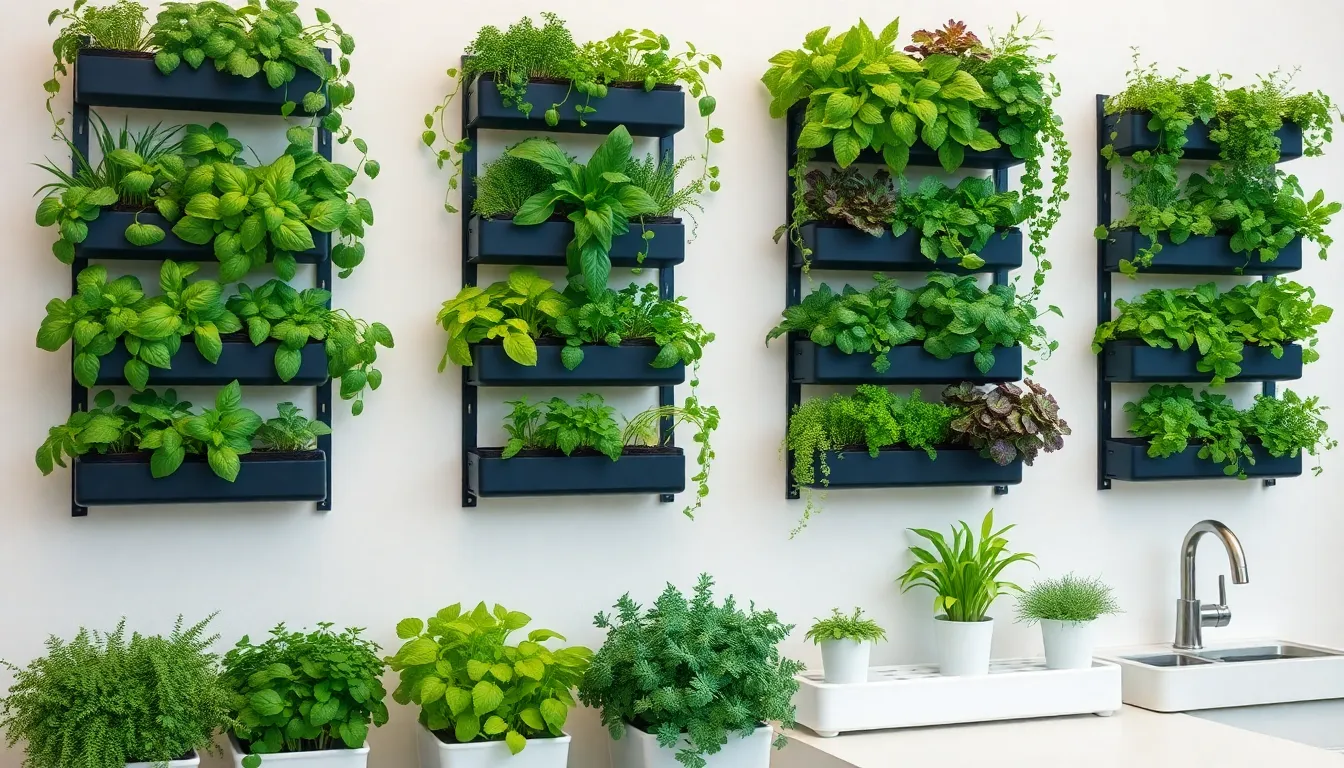
Creating a vertical herb garden transforms unused wall space into a thriving growing area that maximizes your indoor gardening potential. We’ll explore practical answers that work beautifully in any kitchen or living space.
Wall-Mounted Growing Systems
Modular planters offer the most flexibility for wall mounted herb gardens. These stackable units let us rearrange plants as they grow and add new herbs throughout the season. We can easily move individual planters to optimize light exposure or create visual balance.
Hydroponic systems integrate seamlessly into vertical designs for efficient watering. These setups eliminate soil mess while providing consistent moisture to herbs like basil, cilantro, and parsley. We recommend starting with simple hydroponic kits designed specifically for herbs.
Rail systems mount directly to walls using sturdy brackets. Metal rails support multiple planters while maintaining clean lines in modern kitchens. We can slide planters along the rails to adjust spacing as herbs mature.
DIY Vertical Garden Answers
Pallet gardens transform reclaimed wood into functional growing spaces. We attach small pots or create planting pockets between pallet slats for herbs like thyme, oregano, and mint. Sanding and sealing pallets ensures food safe growing conditions.
Magnetic planters stick directly to refrigerators or metal wall panels. These compact containers work perfectly for small herbs and create eye catching displays. We suggest using stainless steel planters that won’t rust in humid kitchen environments.
Hanging planters suspend from ceiling hooks or wall mounted trellis systems. Macrame holders add bohemian charm while supporting healthy root systems. We can create cascading arrangements using herbs of varying heights.
Repurposed materials like old gutters or PVC pipes become creative planting answers. Drill drainage holes and mount these containers horizontally for continuous herb rows. We’ve seen impressive results using shoe organizers as vertical pocket gardens.
Space-Saving Design Ideas
Stacked planters create tiered effects using containers of different sizes. We place larger pots at the bottom with smaller ones above to maximize growing space. This approach works especially well for herbs with varying root requirements.
Vertical plant stands fit perfectly on windowsills or floor corners. These multi level structures support several herb varieties while maintaining easy access for harvesting. We recommend stands with adjustable shelves to accommodate plant growth.
Window box gardens mount directly below windows for natural light exposure. These narrow containers hold multiple herb varieties while keeping plants at eye level for monitoring. We suggest boxes with built in drainage systems to protect windowsills.
Corner installations use often wasted space effectively. Triangular planters or curved mounting systems fit snugly into room corners. We can create stunning focal points using combinations of culinary and aromatic herbs.
Design a Kitchen Counter Herb Garden Station
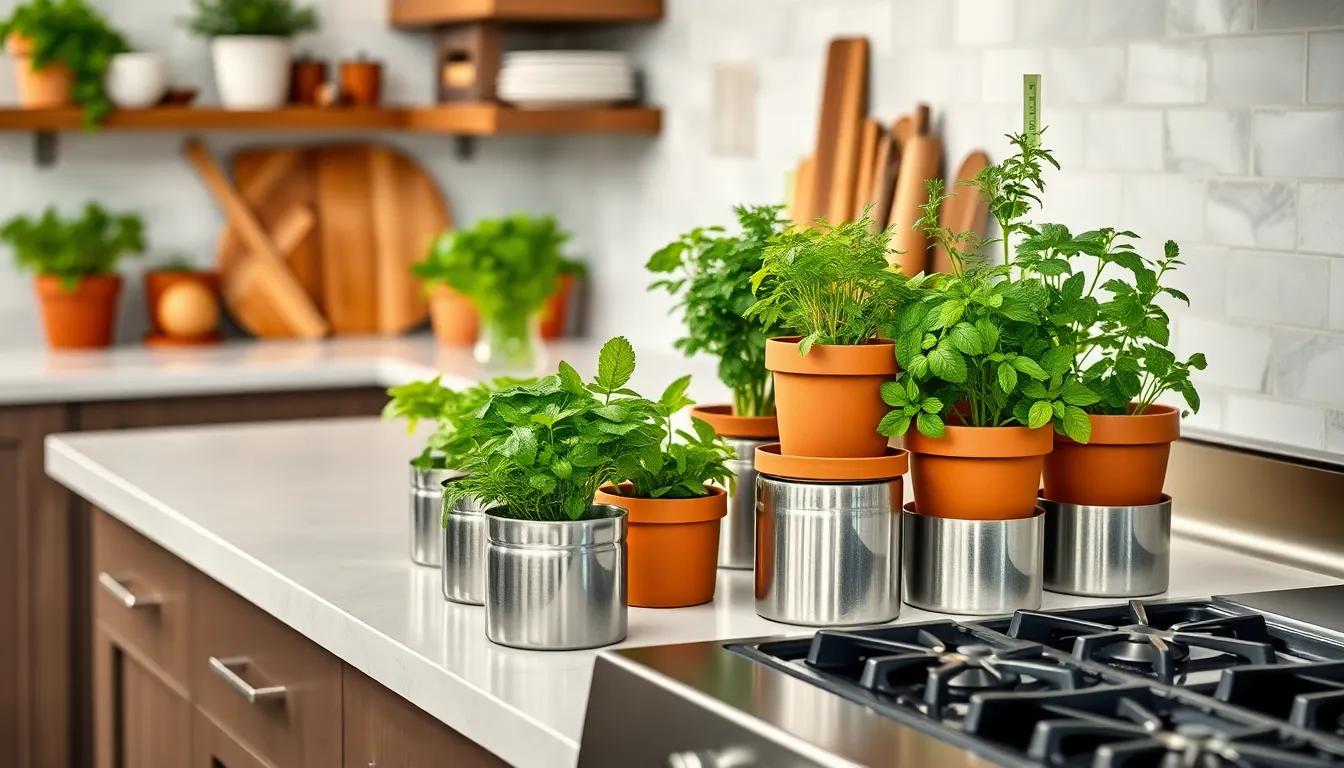
We’ll transform your kitchen counter into a productive herb growing center that seamlessly integrates with your daily cooking routine. Creating an organized herb station ensures fresh ingredients remain within arm’s reach while maintaining your kitchen’s aesthetic appeal.
Compact Counter-Top Answers
Small to medium sized pots work best for counter herb gardens since herbs typically require shallow soil depths of about 6 inches. Terra cotta containers offer excellent breathability for root systems while steel planters provide superior drainage and modern aesthetics. We recommend choosing pots with drainage holes to prevent root rot, which destroys herb plants quickly in confined spaces.
Stackable planters maximize vertical growing space without consuming additional counter area. These systems allow us to grow multiple herb varieties in the same footprint as a single large container. Modular designs enable easy rearrangement when kitchen tasks require more workspace.
Self contained growing kits eliminate guesswork for beginners while maintaining professional results. Many include built in water reservoirs and LED growing lights that supplement natural sunlight during winter months.
Easy Access for Daily Cooking
Position herb stations near your primary cooking area to ensure immediate access during meal preparation. We’ve found that placing containers within 2-3 feet of the stove creates the most efficient workflow for adding fresh herbs to dishes.
Counter height placement eliminates bending or stretching when harvesting herbs throughout the day. This positioning also makes daily watering and maintenance tasks more convenient than floor level gardens.
Organize herbs by usage frequency with basil, parsley, and cilantro in the most accessible spots since these varieties appear in recipes most often. Less frequently used herbs like tarragon or marjoram can occupy secondary positions while remaining easily reachable.
Stylish Integration with Kitchen Decor
Match container materials to existing kitchen hardware and appliances for cohesive visual appeal. Stainless steel planters complement modern appliances while ceramic pots enhance traditional or farmhouse style kitchens.
Create visual groupings using containers of varying heights to add depth and interest to your counter display. We suggest arranging three to five pots in triangular formations that draw the eye naturally across the herb collection.
Add decorative elements like small plant markers or coordinating saucers that protect counter surfaces while improving the overall presentation. Natural materials such as bamboo or cork create warm accents that soften industrial kitchen environments.
Set Up a Hydroponic Indoor Herb System
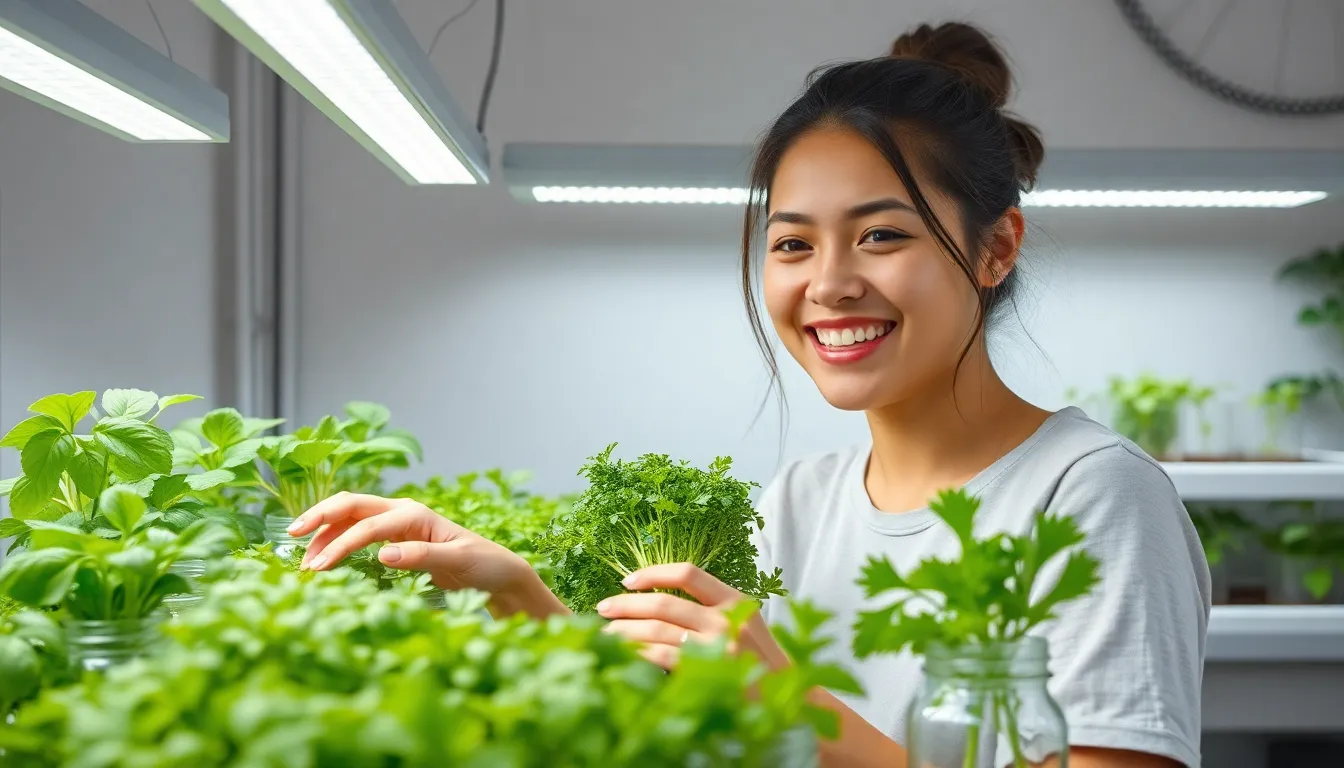
Hydroponic systems offer an innovative soil-free approach to growing herbs indoors with precise nutrient control. We’ll explore how this water-based growing method can transform your herb cultivation experience.
Hydroponic Growing Basics
pH levels require consistent monitoring between 5.5 and 6.5 for optimal nutrient absorption in your hydroponic herb garden. Temperature control maintains ideal growing conditions between 60°F and 70°F (15°C and 21°C) while humidity levels should stay around 40-70%.
Air circulation prevents fungal diseases by keeping moisture from stagnating around your herb plants. Proper ventilation systems ensure healthy plant development and reduce pest problems.
Lighting requirements demand 14-16 hours of daily illumination, with LED grow lights providing the most energy-efficient solution for indoor herb production. Consistent light schedules promote steady growth patterns in basil, mint, and parsley varieties.
Equipment and Supply Needs
Hydroponic methods like the Kratky system work exceptionally well for small spaces using ball jars or mason jars without requiring water pumps. This cost-effective approach simplifies the setup process for beginning hydroponic gardeners.
Growth mediums such as expanded clay pellets provide excellent root support and drainage for your herb plants. These lightweight materials allow proper oxygenation while maintaining moisture levels.
Nutrient answers from hydroponic fertilizer manufacturers supply essential minerals your herbs need for healthy development. Following manufacturer instructions ensures proper concentration levels for different growth stages.
Water pumps and tubing become necessary for larger hydroponic systems that require continuous circulation. LED grow lights complement these systems by providing consistent illumination regardless of natural light availability.
Maintenance Requirements
Nutrient level monitoring involves regular testing and adjustment based on your exact herb plant needs and growth phases. Weekly checks prevent nutrient deficiencies that could impact herb flavor and yield.
Pest inspection requires examining plants regularly for signs of insects or diseases that can quickly spread in hydroponic environments. Early detection allows for immediate treatment before problems become severe.
Harvesting practices should never remove more than one-third of any herb plant at once to maintain healthy growth patterns. Regular harvesting encourages bushier growth and continuous herb production for your kitchen needs.
Establish Proper Lighting for Year-Round Growth
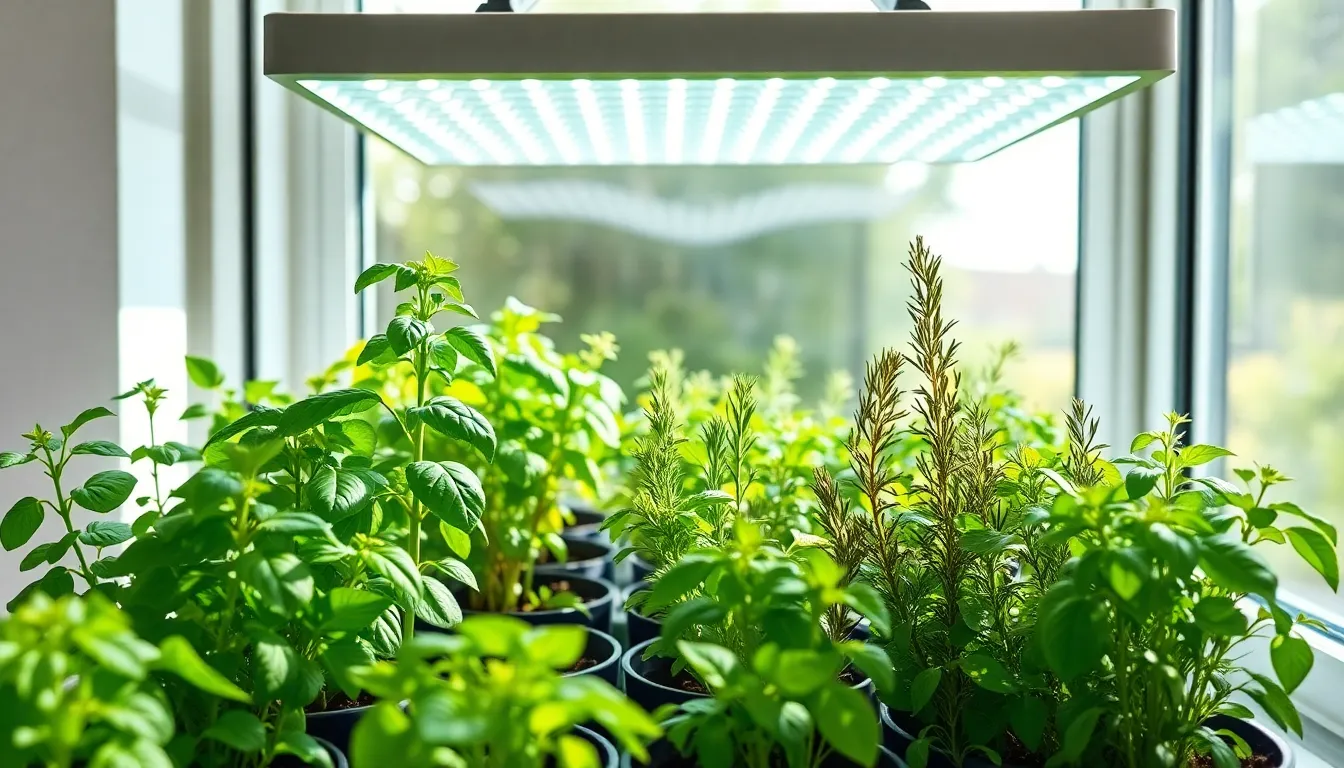
Proper lighting forms the foundation of a thriving indoor herb garden. We’ll explore the most effective lighting answers to keep your herbs growing strong throughout the year.
LED Grow Light Options
LED lights offer unmatched efficiency for indoor herb cultivation and can be customized to promote optimal plant growth. These lights come in various light spectrums, with blue range options (5,000 – 7,000K) specifically designed to encourage vegetative growth in your herbs. Full spectrum LED systems provide comprehensive lighting that mimics natural sunlight conditions.
Position your LED grow lights 6-12 inches away from your herb plants for maximum effectiveness. High-output LED options work exceptionally well for sun-loving herbs like basil, which require more intense lighting conditions. Modern LED systems generate minimal heat compared to traditional lighting, making them safer for close placement to your plants.
Advanced LED systems often include built-in timers and remote controls for convenient light management. Many models allow you to adjust both light intensity and spectrum throughout the day, creating ideal growing conditions for different herb varieties.
Natural Light Supplementation
South-facing and west-facing windows provide the most direct sunlight for herbs that crave intense light conditions, particularly rosemary and basil. These locations receive extended periods of bright light throughout the day, supporting robust growth and essential oil production in your herbs.
North-facing and east-facing windows work perfectly for herbs that prefer partial sun conditions, such as mint and chives. These gentler light exposures prevent leaf burn while still providing adequate energy for photosynthesis. Consider rotating your herb containers weekly to ensure even light distribution on all sides of the plants.
Seasonal light changes require adjustments to your natural light strategy during winter months when daylight hours decrease significantly. Combining natural window light with artificial supplementation creates consistent growing conditions year-round.
Light Timing and Duration
Most herbs require 4 to 6 hours of natural light daily but benefit significantly from 12 to 14 hours of artificial light exposure. This extended lighting period compensates for the lower intensity of indoor artificial lighting compared to direct sunlight.
Sun-loving herbs like basil need 14-18 hours of high-output LED lighting to replicate their preferred outdoor growing conditions. These longer photoperiods encourage faster growth and more robust flavor development in culinary herbs. Mediterranean herbs such as oregano and thyme also thrive under extended artificial lighting schedules.
Automated timing systems simplify light management and ensure your herbs receive consistent daily light exposure. Digital timers eliminate the guesswork and maintain optimal growing conditions even when you’re away from home. Programming different lighting schedules for various herb types maximizes the productivity of your indoor garden setup.
Maintain Your Indoor Herb Garden Successfully
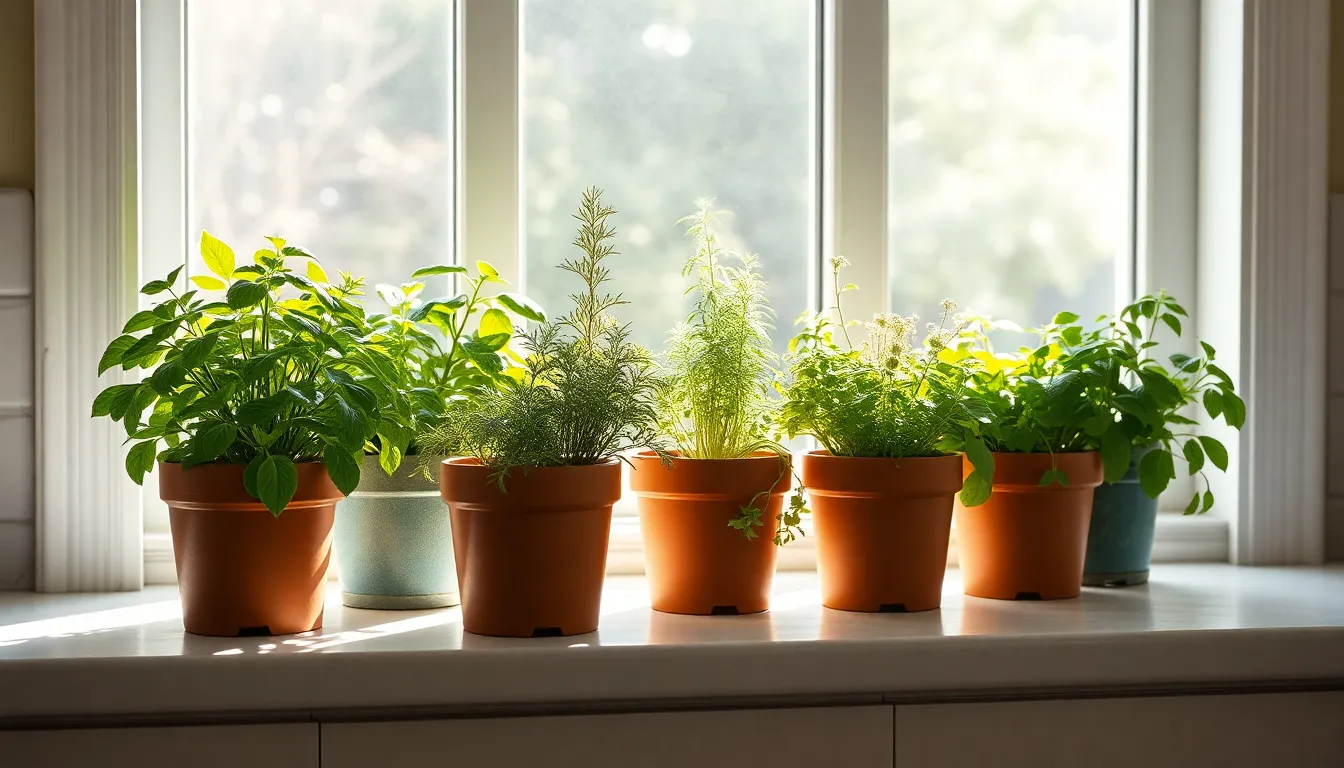
Ongoing care determines the success of your indoor herb garden setup, ensuring healthy plants that produce flavorful leaves for months. We’ll cover essential maintenance practices that keep your herbs thriving year-round.
Watering and Feeding Schedules
Watering frequency depends on checking soil moisture rather than following rigid schedules. Touch the top inch of soil in each container to determine when herbs need water – dry soil indicates it’s time to water thoroughly.
Drainage prevents root rot, which destroys herb plants faster than any other issue. We recommend containers with multiple holes at the bottom, allowing excess water to escape within minutes of watering.
Feeding herbs monthly with organic fertilizers promotes steady growth without overwhelming delicate root systems. Apply liquid fertilizer at half strength during growing season, reducing frequency during winter months when plant growth naturally slows.
Temperature affects watering needs, requiring more frequent attention during warm periods. Summer conditions may demand daily soil checks, while winter herbs often need water only twice weekly.
Pruning and Harvesting Techniques
Trimming encourages bushy growth by preventing herbs from developing long, leggy stems. Cut back growth points regularly, focusing on areas where leaves cluster together for maximum branching.
Pinching individual leaves provides fresh herbs for cooking while maintaining plant health. Select outer leaves first, leaving inner growth to continue developing for future harvests.
Flowering reduces leaf production, making it essential to remove flower buds as soon as they appear. Snip flowering stems immediately to redirect plant energy toward leaf development instead of seed production.
Regular harvesting keeps plants productive by stimulating new growth cycles. We suggest harvesting no more than one-third of each plant at once, allowing adequate foliage to remain for photosynthesis.
Common Problem Prevention
Pest inspection catches problems like aphids and spider mites before they spread throughout your herb collection. Check leaf undersides weekly, looking for tiny insects or webbing that indicates pest activity.
Neem oil treatment eliminates most common herb pests without harmful chemicals that affect food safety. Apply neem oil solution in early morning or evening to avoid leaf burn from direct sunlight.
Fungal diseases develop from overwatering and poor air circulation around herb containers. Space plants adequately and avoid watering leaves directly, focusing water application on soil surfaces instead.
Fungicide application becomes necessary when yellow spots or fuzzy growth appears on herb leaves. Use organic fungicides specifically designed for edible plants, following package directions for safe application timing before harvest.
Conclusion
Creating your own indoor herb garden transforms your kitchen into a year-round source of fresh flavors and aromatic ingredients. We’ve explored everything from choosing the perfect location and containers to selecting the right herbs and maintenance techniques that’ll keep your garden thriving.
Whether you opt for a simple windowsill display or an elaborate hydroponic system the key is starting with what works for your space and lifestyle. Remember that even the smallest herb garden can make a important impact on your cooking and your wallet.
The journey from seed to seasoning is incredibly rewarding and we’re confident that with these ideas and techniques you’ll soon be enjoying the unmatched freshness of homegrown herbs in every meal you prepare.
Frequently Asked Questions
What are the main benefits of growing an indoor herb garden?
Indoor herb gardens provide fresh herbs year-round at a fraction of store-bought costs. They offer superior flavor compared to dried herbs, convenient access while cooking, and can enhance your kitchen’s aesthetic appeal. Additionally, you’ll have control over growing conditions and can avoid pesticides used on commercial herbs.
Which herbs are easiest for beginners to grow indoors?
Basil, parsley, cilantro, and dill are ideal starter herbs for beginners. These varieties adapt well to container growing, tolerate varying light conditions, and grow quickly. They’re also commonly used in cooking, making them practical choices for new indoor gardeners.
What type of lighting do indoor herbs need?
Most herbs require 4-6 hours of direct sunlight daily. South-facing windows provide optimal natural light, while east and west-facing windows work for many varieties. When natural light is insufficient, LED grow lights positioned 6-12 inches above plants can supplement or replace sunlight effectively.
What containers work best for indoor herb gardens?
Terra cotta, cedar, and steel containers are excellent choices. Ensure all containers have drainage holes to prevent root rot. For small spaces, consider vertical planters or self-watering systems. Container size should accommodate root growth – typically 6-8 inches deep for most herbs.
How often should I water my indoor herbs?
Check soil moisture by inserting your finger 1-2 inches deep. Water when the top inch feels dry, typically every 2-3 days. Avoid overwatering, which causes root rot. Different herbs have varying water needs, so monitor each plant individually for best results.
Can I grow herbs without soil using hydroponic systems?
Yes, hydroponic systems allow soil-free herb growing with precise nutrient control. You’ll need growing medium, nutrient solutions, and proper lighting. While requiring more initial setup and monitoring of pH levels and nutrients, hydroponics can produce faster growth and higher yields.
How do I harvest herbs without killing the plant?
Harvest in the morning after dew evaporates for best flavor. Cut stems just above leaf nodes to encourage new growth. Never harvest more than one-third of the plant at once. Regular harvesting actually promotes bushier growth and prevents flowering.
What’s the best location for an indoor herb garden?
Choose locations with consistent temperature (65-75°F), good air circulation, and adequate light. Kitchen windowsills are popular for convenience, but any spot meeting light and temperature requirements works. Avoid areas near heating vents or drafty windows that cause temperature fluctuations.

